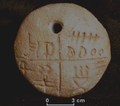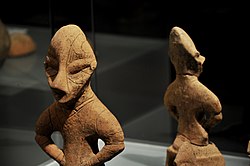Vinča culture
The Vinča culture was a culture that existed during the Stone Age, from around 5400 BC to 4600 BC. It was the first to develop the knowledge and skills to process copper, in the late 6th millennium BC.[2]
The culture is named for a large site found close to modern-day Belgrade, Serbia. Other sites have also been discovered in Romania, Hungary and Bosnia.
Vinča artifacts include many ceramic figurines. Some of these have symbols on them which have been interpreted as an early form of writing. These symbols are called Vinča symbols.
Tărtăria amulet, showing some of the symbols found
Clay figurine, British Museum.
Vinča Culture Media
Copper axe from Pločnik, Serbia, c. 5000 BC
One of the Tărtăria tablets with Vinča symbols, dated to 5500–5300 BC
The Tărtăria tablets
Vinča figurine, the Goddess on the Throne













